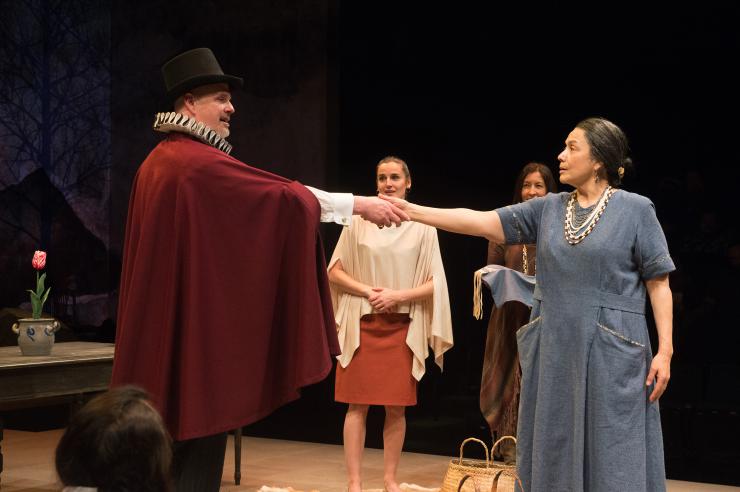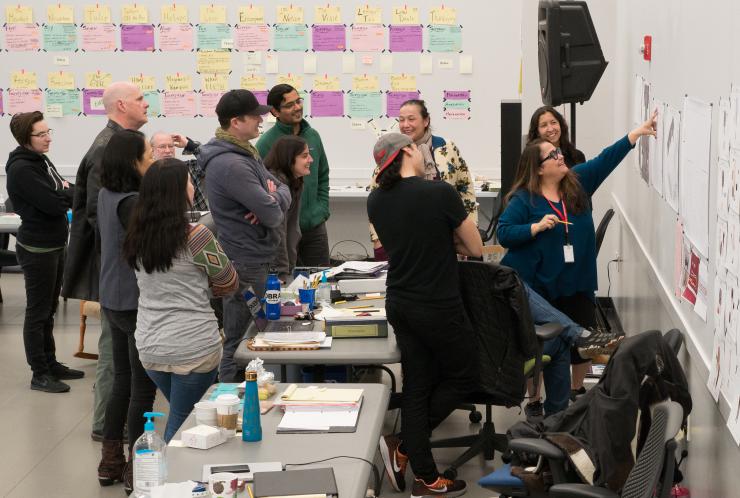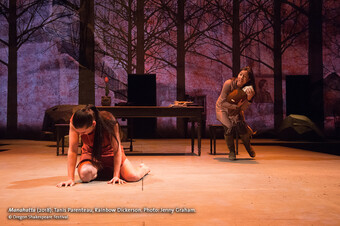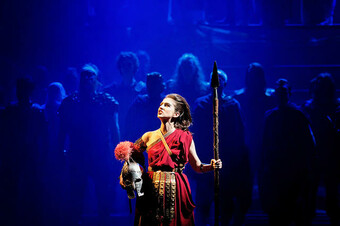Manahatta's Gender Flip
Equity in Action
As an advocate for creating equity in the American theatre through consciously changing whom we choose to represent on stage, I am often told, “but that would interfere with the creative process.” The playwright’s vision, some argue, would be compromised by any effort to pursue casting quotas. The dictum “don’t tell the playwright what to write,” though generally sound dramaturgical advice, can be used as an excuse not to do the hard work necessary to creating change.
Not so with Manahatta, by Mary Kathryn Nagle, which premiered at the Oregon Shakespeare Festival (OSF) in March 2018. Since being chosen for OSF’s 2018 season almost a year ago, Manahatta has undergone not only the usual rewrites, but also a very specific transformation initiated by Artistic Director Bill Rauch: Nagle flipped one of the main characters from being a man to being a woman. Not only did this not interfere with her vision, but she is actually able to better represent the cultural reality of her subject matter.
'[A] matrilineal society is … not about recreating the patriarchy and putting a woman at the top. It’s about an entirely different structure where there isn’t a hierarchy.'
Manahatta tells the story of the 2008 financial crisis alongside the story of the “purchase” by the Dutch from the Lenape of what is now called Manhattan. In what is becoming a Nagle trademark, every actor plays a role in each time, often transitioning without leaving the stage, so that history becomes the present and the present becomes history right before the audience’s eyes. One actor plays the character of Bobbie, mother to the protagonist, Jane, in the 2008 timeline, and Mother in the seventeenth century timeline. Though Nagle’s initial instinct was to create a father character named Robert, Rauch suggested she change the sex to create a role for OSF company member Sheila Tousey.
I talked about the change with Nagle, dramaturg Leslie Ishii, and director Laurie Woolery, who remembers the moment Nagle accepted the challenge:
She gave her answer when we were on the phone. We were all around the table kind of leaning in because it was a radical ask—Bill asked the playwright to change the gender. There was this moment when it felt like the idea entered her brain and then dropped down into her heart and it was like, “Yeah.” It was this wonderful awakening. For me, I was just wondering what the ramifications of that would be, but Mary Kathryn just did such a leap of “Aaaaaah! Let’s do it!
In many ways, changing this central character from a father to a mother did not change the story Nagle set out to tell. Her inspiration for the story has always been the same:
The modern day trauma that we’re comparing to the trauma of the past is the loss of home. The 2008 housing crisis hit so many communities in the United States: communities of color, white working class families, you name it—I don’t think it spared anyone except for the wealthy. So that story, I hope, will create a little bit more of an entry point for some people whose hearts and minds might be closed off to trying to understand the indigenous experience on Turtle Island. I'm hoping what they’ll see is that our failure to understand how Wall Street began in 1654 is what allowed the crisis of 2008 to happen. The dehumanization of the first people to live on this land actually dehumanizes us and harms us all now.
Early drafts of Manahatta show that this has been Nagle’s intention all along, and flipping the gender of Robert did not interfere with that or even change the plot of the play at all. Every choice that Robert made is logical for Bobbie to make as well. On the other hand, the change has enhanced thematic elements, subtext, and the dynamic in the rehearsal room in ways that are good for both the play and the artists. Woolery shared,
What it ignited was mother-daughter relationships that completely shift the play in a different way, in a really interesting, complicated way, because now the house is filled with three powerful women, as opposed to two daughters and a father. The dynamic is so different than it would have been the other way around.
Ishii elaborated,
The matrilineal values are carried forth in a particular way through Jane, [Bobbie’s daughter], and her connection to [those values] is an interesting arc through the play. And then when she goes to Wall Street into a completely patriarchal set of values and ways of functioning, you have some really interesting dramatic tension in the play, and with what that means for Jane’s character with Bobbie’s influence and her family’s legacy. That sets up a whole different paradigm than if Bobbie would have been Robert.
This paradigm, it turns out, better reflects Lenape culture. Nagle herself is Cherokee, but has been working with Curtis Zunigha, a Lenape tradition bearer and cultural consultant, throughout her process. Lenape culture is matrilineal, but not, as Nagle clarified for me, matriarchal:
To me, when I hear the word matriarchal I think, copying the patriarchy and just replacing the person at the top of the hierarchy with a female. And a matrilineal society is not a matriarchy; it’s not about recreating the patriarchy and putting a woman at the top. It’s about an entirely different structure where there isn’t a hierarchy. So if you look at traditional Lenape culture, it’s not about a hierarchy. There are different roles for different genders but it’s not about placing one in a more powerful position than another. There are just different roles and responsibilities.
In the seventeenth century timeline, the clan is led by Bobbie’s counterpart, simply called Mother. In one scene in particular—the scene in which the Lenape supposedly sell their land—a Dutch trader asks a Lenape man who speaks English, “Are you the leader?” In the OSF staging of this moment, the Lenape women laugh at this, and the man refers the trader to Mother.

The script does not have a stage direction for the laughter, and this scene was in early drafts without major differences. But as Woolery noted,
I feel like, if that had been a father, for an audience who doesn’t understand this cultural distinction, it would have felt more like a patriarchy. Having a female in that role, we are able, without it being an educational lesson, to reflect that [matrilineal structure] in how [the Lenape] community interacts with the two Dutch traders.
The rehearsal process, says Woolery, has been one of rewiring their brains to be able to imagine what a non-hierarchal society would look like:
We had to call ourselves on words like, “I'm defending her,” or, “allowing her to go trade.” That equity is challenging us as art makers to have to try to shake off, to chip into the roles that are so deeply engrained in our brains, and that even influence acting choices. So that has been a really beautiful gift of this work, to try to rewire that and find these moments in those scenes where we can, to the best of our abilities, show equity and respect among those Lenape characters and not fall into the trope of man protecting his woman or man allowing his woman or man taking the lead in any way. That has been exciting. And that wouldn’t have happened if Robert had remained male.
In other words, accurately representing Lenape culture requires a constant awareness that the very actions we choose to play on stage are often infected by patriarchy and white supremacy. Even artists steeped in feminist thought and the values of equity, diversity, and inclusion need help reframing the way they think and talk about social structures when telling stories that are not their own. When I asked whether the gender equality in Lenape culture exists in other tribes, Nagle corrected me:
Equality is such a white feminist word. It’s problematic when applied by a colonizing culture to indigenous cultures because a lot of times, white feminists show up and they’re like, “What?! The woman is made to do this and the man does that? That’s not equality! Women can’t sit at the drum? That’s not equality!” And it’s like no, no, no, American culture has put that value on us. Women weren’t relegated to the domestic sphere in the home and held significant leadership roles of great respect within their communities. But then the boarding schools came along, and all of these different forms of colonial power in the United States that were designed to teach native women that they were to be domesticated and less than. And so equality is a weird word for me when I’m talking about indigenous cultures. I know what it means in the United States for white feminists, and I don’t see it having the same meaning in tribal communities. And then I see us getting judged for that.
Even artists steeped in feminist thought and the values of equity, diversity, and inclusion need help reframing the way they think and talk about social structures when telling stories that are not their own.

Being called on our misunderstandings need not be uncomfortable, though it does require a certain amount of humility. Ishii, a facilitator for the Art Equity training program, which aims “to create a diverse, well-equipped cadre of national facilitators who can support equity-based initiatives nation-wide,” shared,
This decolonizing of a space is not usual but needs to be. As we work to get more inclusive in the American theatre, it is problematic that decolonization isn’t a best practice. Manahatta illuminates repetition of colonialist patterns. So for this space to have been as rigorous as possible to decolonize our settler minds—to be conscious working with Mary Kathryn, guided by Curtis Zuniga, and while also consulting with Ty Defoe, Movement Director, of us being given the great responsibility by Curtis to share and tell this story—that is not usual in the American theatre. And the process Laurie brings to it, that’s transparent and equitable in the room so every player, no matter what position you’re in, has a voice, I mean really has a voice, is unprecedented. It’s thrilling to me personally, because to me this is how we are going to reclaim our humanity. I'm reclaiming my humanity, where colonialism and white supremacy has stolen it. And it’s really stolen it from everyone.
Many artists are understandably wary of the hard work required to rewire their brains away from patriarchal and white supremacist paradigms. But it is worth it to do that work, even when those paradigms privilege you. And, as Manahatta proves, asking that playwrights help create equity in casting need not stifle their creative process. Rather, it can lead to the creation of even more interesting work than they could ever, without that collaboration, have imagined.










Comments
The article is just the start of the conversation—we want to know what you think about this subject, too! HowlRound is a space for knowledge-sharing, and we welcome spirited, thoughtful, and on-topic dialogue. Find our full comments policy here
Wonderful. Thanks for sharing this intimate process and all the great ripples.